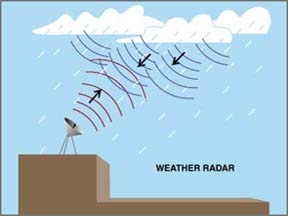Click on image for full size
Courtesy of University Corporation for Atmospheric Research
Related links:
Hail
Hail develops in a cumulonimbus cloud from graupel, large frozen raindrops, that are tossed around the cloud by wind. The top of a cumulonimbus cloud reaches to high altitudes where temperatures are cold enough for water to freeze. A hailstone grows larger when supercooled water droplets freeze on contact with the hailstone. The longer the ice crystals are tossed within the cloud, the larger the hail becomes. When the hailstones become too heavy, they fall to the ground.
Most hailstones are about the size of peas even though they may have started out much larger. As hail falls from a cloud, the ice starts to melt because the temperature of the air below a cloud is warmer than it was in the cloud. Hailstones do not have a perfectly round shape because of this. Some hail reaches the ground as rain either because of warmer air temperature below the cloud or because the hail was small when it fell from the cloud. Hail can fall during violent thunderstorms in the summer. In cumulonimbus clouds, hailstones can grow so large and fall so quickly that warm summer temperatures don't completely melt them before they hit the ground.
The heaviest hailstone in the United States was the size of a cantaloupe and fell on Coffeyville, Kansas in September of 1970. This hailstone weighed 1.67 pounds. In Canada, the largest hailstone measuring 4 inches (10cm) fell on Saskatchewan in August of 1973. Hail is either transparent or partially opaque.
Large hailstones can break windows, dent cars, damage roof of homes, and cause extensive damage to crops. One hailstorm can destroy a farmer’s entire crop in mere minutes. In the United States alone, it is estimated that hail causes hundreds of millions of dollars in damage annually.














